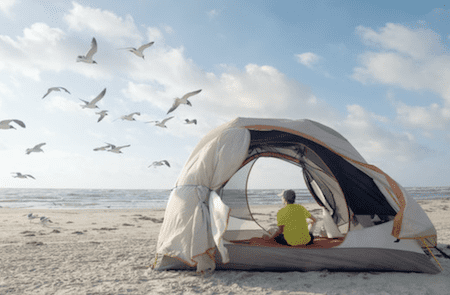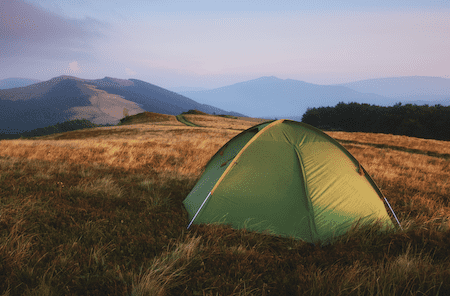The tent is an essential part of any outdoor adventure because it protects us from the elements such as the sun, rain, snow, and wind. However, the environment does not always cooperate.
If you go camping with your tent, one of the most frustrating things that can happen is that when you return to your campsite, your tent has blown away. Have you ever experienced anything similar?
The wind is a major concern since it can blow your tent away even if it’s anchored to the ground with stakes or rocks. But knowing how to stop your tent from blowing away can obviously help you improve the wind resistance of your tent.
So, to help ensure your tent won’t blow away during a medium wind speed (up to 50 km/h), here are seven tips you can follow.
How You Can Stop Your Tent From Blowing Away?
Basically, a tent can withstand winds of up to 30 km/h, but by doing the following, you can increase your tent’s wind resistance by up to 40 to 50 kilometers per hour and keep yourself safe.
Let’s begin this process:
#1. Examine The Weather Forecast Carefully
Make sure you think about and examine the weather forecast before going out. Because the wind does not come alone. So, check if there is a possibility of severe rain, storms, thunderstorms, or hail.
Yes, you must carefully study the weather forecast as you will have to decide whether you should go out or cancel the trip.
Rather than placing yourself in danger, remain at home for a few days & then go camping when the weather permits. So, the first tip tells you that only go camping when it is most safe.
#2. Select The Right Tent Based On The Weather Condition
If you want to go outdoors in this kind of terrible weather, you must get a 3 or 4-season tent. Because these kinds of tents are meant to let you survive in extreme weather conditions.
At the same time, you should avoid using a 2-season, pup, pop-up tent, or even a canopy at a certain time of the year. And most importantly, you should buy a high-quality wind-resistant tent, as a low-quality tent can ruin your vacation.
#3. Analyze The Wind Direction And Select The Best Location
Normally, the wind’s intensity varies with its location; it is generally greater near lakes or seas. In contrast, valleys can occasionally create natural wind tunnels with much stronger winds just 100 meters away from the bend.
Also, check the soil of the place you are choosing because if the soil is too loose, the pegs will not remain stable. Similarly, if the soil is too hard, it may be harder to anchor the pegs. So, it would be ideal if you chose a place where the soil would be nearly perfect for anchoring pegs.
Make absolutely sure you are setting your tent in a higher place. A flat surface would be ideal. Because in lower places, a small amount of rain can make the place a mini pond. Also, try to avoid places like under a tree or at the top of a hill.
#4. Set Up Your Tent, Focus On Anchoring Properly
Once you have selected the right location, now you will have to erect the tent. You can read the user’s manual for the setup. But the best way would be to practice the setup process at home before you go camping.
Well, when you are setting up your tent, make sure you are paying special attention to anchoring the stakes properly. Many tents include built-in stakes, but you should buy them separately if those stakes are not made with steel.
On the other hand, look for steel stakes with a looped point so you can tie the rope more firmly to the stakes.
Using the proper knot might also be beneficial. The taut-line hitch knot is one of the best knots for securing a tent. This form of knot maintains the rope securely linked to the stake while allowing for ideal line tension.
Many tents include additional slots where extra pegs can be inserted. Additionally, you must have some backup ropes and pegs so that you may use them as necessary. On a gusty day, larger and longer stakes are preferable.
#5. Put Additional Wight On Your Tent Stakes
In addition to tent pegs, consider putting sandbags, rocks, or other materials between the tent’s legs to ensure its sturdiness. When you use bags, which may be filled with stones or sand, they would provide extra weight on your tent legs and help it resist more wind.
Using additional stakes is necessary, but adding more weight to them might be critical. You should use a different sandbag for each stake. If you don’t have any bags, you can fill an old pillowcase with sand or stones to get the desired weight.
Yes, the more sandbags you use, the more secure your tent will be against the wind.
#6. Create A Windshield: Using A Tarp Can Help
Before the storm begins, or the wind’s speed goes up, you can try to create a windshield from wood, stones, or even snow. I know it’s difficult, but you need to gather some rocks, hardwood, or snow to build a wind-proof wall. This will help you defend your tent from strong winds.
Also, using a supplementary tarp can provide additional protection for your tent. Placing the tarp correctly over your tent and ensuring it is securely pegged can help to protect against wind and make your tent watertight.
#7. Remove Your Tent’s Sidewalls If Your Tent Has
Listen, you can’t secure your tent from heavy winds like 120 km/h. So, if you can’t create a solid windshield, consider removing your tent’s sidewalls. Well, for that reason, you should buy a tent that features a removable side wall.
Removing the side wall will help to reduce wind forces on the tent. Rather than smashing out the poles, it would flow through the tent.
Well, these are the seven ways you can follow to stop your tent from blowing away at medium wind speed.
So, When Should You Leave Your Tent And Let It Blown Away?
We must recognize that a tent cannot protect us from extreme weather conditions, such as when the wind picks up to 130 km/h.
So, if the weather conditions go worse than you expected, remember the following things you can do which may save your life:
- If you see your tent poles coming out of the ground or trees around you falling down due to the heavy wind, you must try to take your tent down. But if you feel that it is too late to take your tent down, you should leave your tent and go out and search for a shelter.
- If there is no place to go, go in your car. And if you are far away from your car, then try to find a big tree and save yourself under it.
- You should immediately call the emergency number to ask for help.
Yes, doing these three things may help you survive even in such a bad weather situation if you are lucky enough.
What Things Can You Carry To Survive If The Weather Turns Extremely Bad?
Before you go out of your home for camping, make sure you are carrying the following goods with you:
- Carry a power bank to charge up your phone. Your battery may run out of power after a day or two.
- Bring at least one lighter with you. It can help you ignite a fire when you need it.
- Carrying a torch is always beneficial. It can let you navigate at night.
- A box of first aid would be worth bringing. It can help you with the initial treatment.
- Yes, bring some food and drinkable water with you since they are essential for our lives.
Maybe there are more things you can carry with you in order to protect yourself, but the above 5 things will always be worth carrying.
Frequently Asked Questions
What Is The Highest Wind Speed A Tent Can Withstand?
There are different types of tents, and each kind has its own different ability to perform in different levels of windy conditions.
But generally, a tent can withstand up to 30 km/h. But, if you buy a good quality tent and secure it as per the procedures we talked about, then the possibility can increase to 40 to 50 km/h.
How Much Weight Is It Required To Keep A Tent In Place?
It depends on the size, the weather, and the place you are putting your tent. But on average, it would increase your tent’s wind resistance if you put 50 pounds of weight on every stake of your tent. It means as much weight as you can put over will simply increase the possibility of surviving in the heavy wind.
Do You Need To Hang A Tarp Over Your Tent?
Hanging a tarp over your tent can protect you from high sunshine, rain, snow, and even wind. So, it would be a great way to protect yourself if you go camping for more than two or three days.
Because you don’t know what the weather will be like after 10 days, keeping a tarp and hanging it over your tent would always increase your safety.
What Will You Do In A Tent While A Thunderstorm?
If it starts thundering, you should try to find a shelter nearby and go under it. It could be a hut or a concrete structure.
You can also take shelter inside your car because a tent is not a safe place to stay. But if you don’t have such a place nearby, stay in the middle of your tent and wait for the storm to pass.
Which Kind Of Tent Can Withstand Wind Better?
In terms of wind resistance, 3 and 4-season tents outperform any 2-season tent, pop-up tent, pup tent, or canopy.
But, even if you buy a 3 or 4-season tent for camping, you must know how to secure your tent as we mentioned. To get the best wind protection. Otherwise, your tent may blow away in even medium winds.
Final Words
As we all know, an average tent can only stand tall against up to 30 km/hour. Knowing how to stop your tent from blowing away can surely increase the probability of withstanding up to 40-50 km/h.
So, whenever you go camping, make sure you check the weather forecast for that area, place your tent in a good place, and secure it with the stakes and other equipment we talked about.
However, don’t forget to take your tent down if there is too much wind, because tents are not meant to withstand blowing wind at 100 km/h.


